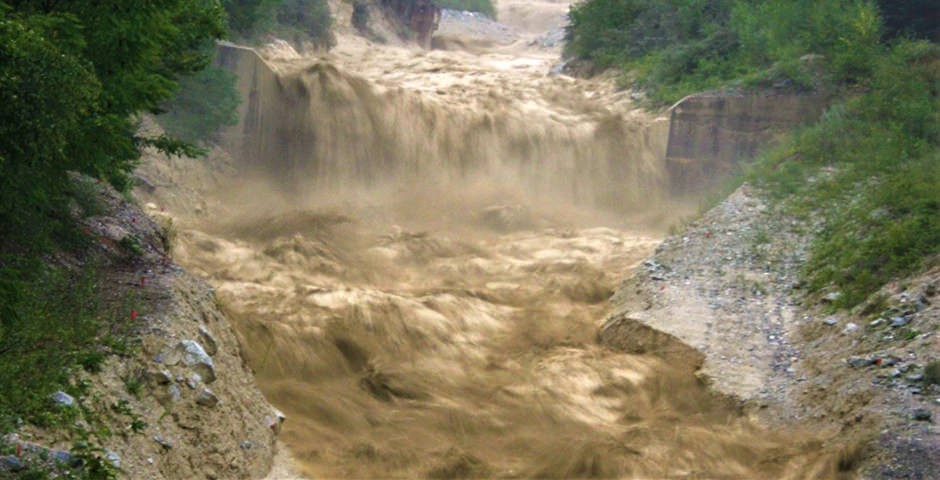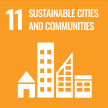
The village of Bondo in Bergell may only have 200 inhabitants but it has been well-known all-over Switzerland for about three years. In August 2017, a debris flow destroyed large sections of the village. The mudslide was caused by a rock avalanche which resulted in eight deaths. Researchers are warning that such natural disasters will occur more frequently in future. One decisive catalyst for this is climate change.
Due to the fact that it is getting hotter in Switzerland and all over the world, increasingly severe storms and other natural hazards are occurring. In addition, the Alpine permafrost is heating up. That and heavier precipitation are destabilising mountainsides and leading to more frequent rockslides and debris flows. These effects of climate change are already endangering the inhabitants of certain regions today in very concrete ways.
Debris flows are a danger to both people and infrastructure
If there is loose material lying on a steep slope such as scree or soil, it can start to move in case of heavy rainfall and thunder into the valley as a debris flow. This puts both people and infrastructure at risk. Debris flows effortlessly sweep away railway lines, bridges, roads or buildings. The Federal Office for the Environment calculated that from 1972 to 2019, debris flows or flooding caused 13.4 billion francs worth of property damage. Since 1946, 24 people have died from debris flows in Switzerland.
The effects of climate change create favourable conditions for such natural disasters. That is why in future even areas in which the risk of debris flows is currently rather small will be affected. Hence, people and infrastructure must be better protected.
Swisscom and ETH Zurich therefore jointly developed the Smart Nature Screener. The alert system warns those affected of natural hazards like rock avalanches and debris flows in good time. The solution detects vibrations in the ground or other irregularities in real time and triggers corresponding alerts. In this way, it would for example be possible to block an at-risk section of railway track or evacuate people in time.
Debris flow in the Illgraben (Source: WSL)
Data platform makes at-risk areas safer
In order to ensure that the system detects dangers of various natures with enough certainty, lots of different data is required. The Smart Nature Screener is therefore a datahub platform which collects and analyses data from different sources.
Vibrations in the ground are recorded and sent to the data platform by seismological sensors of the ETH, seismographs of the Swiss Seismological Service or IoT sensors of Swisscom. There is also the option of identifying movements in the ground via Swisscom’s optical fibre cables. Working with this optical fibre analysis technology could be a particularly efficient data capture option in the future as the fibre-optic network is laid in the ground all over Switzerland in any case. This would mean that fewer additional IoT sensors would be required when new areas are connected to the alert system, and nationwide monitoring would theoretically be possible. Weather services’ precipitation values and mobile phone data also serve as a data source for the platform. Thanks to the knowledge that people are in an at-risk area, the current threat status of the debris flow can be better estimated and appropriate action can be taken.
The strength of the datahub platform lies in its ability to standardise data from the most varied of sources if required, thus making it possible for it to be assessed with the help of artificial intelligence. The data is transferred via Swisscom’s Long Range Wide Area Network, which is available Switzerland-wide, or transferred via the mobile network and processed in Swisscom data centres irrespective of location and using cloud-based technologies. The data therefore always remains in Switzerland.
Pilot project in Valais
The solution is currently being tested at the Ill graben in Valais. Debris flows occur on a regular basis near this mountain stream which in the past resulted in property damage. Large debris flows can burst the stream bed, thus putting people at risk. The alert system correctly identified debris flows during the test phase with 99% certainty in real time. The period between the alert being triggered and the arrival of the debris flow near the cantonal road in the Rhône Valley was up to three hours.
In future, forecasts should also be possible
The added value that the Smart Nature Screener has over conventional solutions is that the alerts are triggered considerably quicker. Thanks to the diversity of data, in future it will also be possible to forecast events like debris flows and to take appropriate measures earlier. If, for example, sensors repeatedly detect seismic activity like scree movements in a particular area and if the weather services predict strong rainfall, there is a greater risk of a debris flow. Tourists or other people affected can be informed and take action. Hikers would have more information available to them on which they could base their decision as to which route to take and would decide on a different route in case of imminent danger. Such a scenario could, for example, be realised with a warning app. At-risk areas would become more attractive to the tourism industry again thanks to the greater certainty and inhabitants could protect themselves effectively. With the planned expansion, it would even be possible to issue situational assessments for the whole country, and people and infrastructure could be protected against the consequences of natural hazards.
Latest news about Swisscom
Subscribe to News
Contact us
Address
Swisscom
Media Relations
Alte Tiefenaustrasse 6
3048 Worblaufen
Postal address:
Postfach, CH-3050 Bern
Switzerland
Contact
Tel. +41 58 221 98 04
media@swisscom.com
Other contacts
Contributing to sustainability
The new solution of Swisscom and ETH Zürich is making an effective contribution towards the UN’s Sustainable Development Goals (SDG).

SDG 3: The warning system helps to protect the population and visitors from debris flows and other natural hazards.

SDG 11: By using the warning system, buildings and infrastructure can be protected from damage caused by natural hazards.
